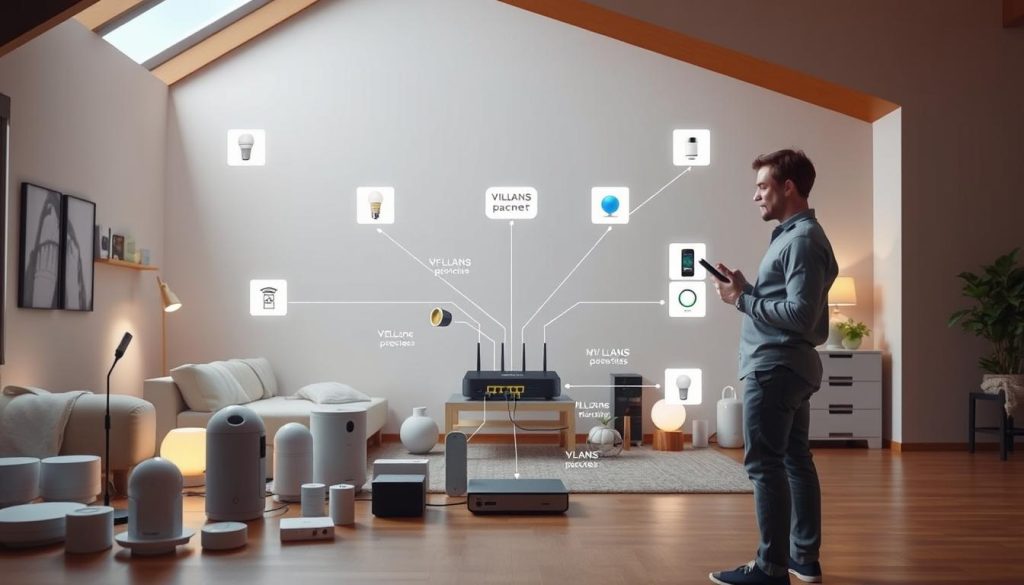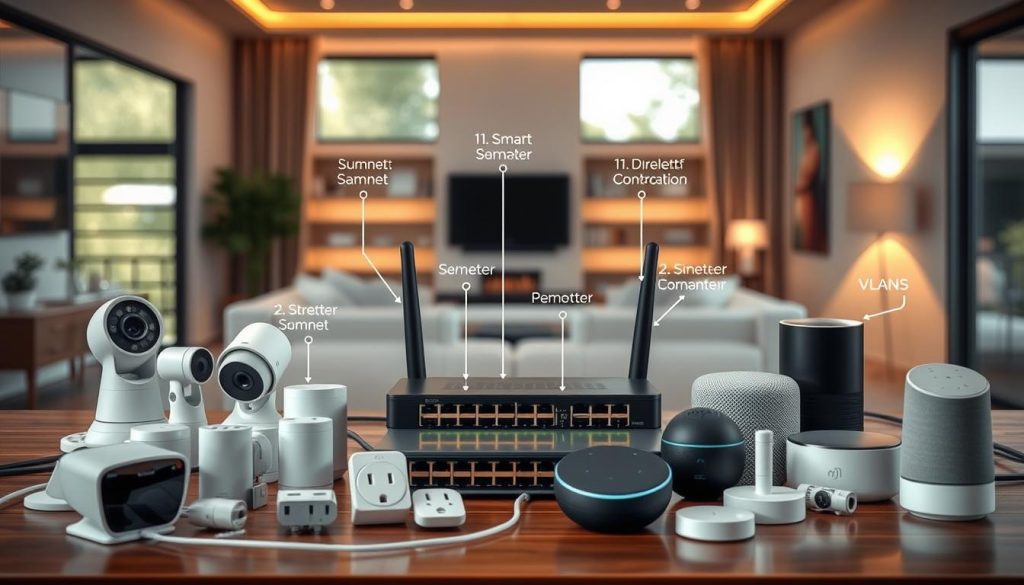As you add more smart devices to your home network, you might be inviting cyber threats. Smart home devices are becoming popular targets for hackers because they connect to the internet.
Using VLANs and subnets can greatly boost your home’s security. This method helps keep breaches contained and lowers the risk to your network.
Learning and following VLAN security best practices is key. It helps shield your smart home devices from unauthorized access and cyber threats.
Key Takeaways
- Isolating smart home devices improves overall network security.
- VLANs and subnets are effective tools for device isolation.
- Implementing VLAN security best practices is crucial.
- Isolation helps contain potential breaches.
- Reducing the attack surface enhances home network security.
Understanding VLANs and Subnets
Network segmentation is key for smart home security. VLANs and subnets are at the heart of this strategy. Knowing these concepts is vital for securing your smart home devices.
What is a VLAN?
A VLAN, or Virtual Local Area Network, divides your home network into smaller groups. This makes it easier to manage and secure your devices. It helps to isolate devices into separate networks.
VLANs are great for smart homes with many devices. They keep a compromised device from accessing other devices’ sensitive info.
What is a Subnet?
A subnet, or subnetwork, is a part of a network with a shared subnet mask. It helps divide your network into smaller parts. This makes managing IP addresses and improving network performance easier.
Subnetting is essential for organizing your smart home network well. It helps optimize network resources, improve performance, and adds security.
Key Differences Between VLANs and Subnets
VLANs and subnets are both for network segmentation but have different roles. VLANs work at the data link layer (Layer 2) of the OSI model. Subnets work at the network layer (Layer 3).
| Feature | VLANs | Subnets |
|---|---|---|
| Layer | Data Link Layer (Layer 2) | Network Layer (Layer 3) |
| Purpose | Segment devices for security | Organize IP addresses and improve performance |
| Scope | Local Area Network | Network and beyond |
It’s important to know the differences between VLANs and subnets. This knowledge is crucial for a good network segmentation strategy in your smart home.
Importance of Smart Home Security
Smart home devices are now a big part of our lives. But, they also bring big security risks if not protected well. The convenience they offer is great, but we must be careful.
It’s important to know the weak spots in your smart home. This helps keep your personal info safe and your network secure. Recent events show how serious these risks can be.
Recent Security Breaches in Smart Homes
There have been many cases where smart home systems were hacked. For example, hackers got into smart door locks and cameras. They got into homes and stole personal data.
These hacks can cost you money and put your safety at risk. It’s key to know about these threats and act fast to protect your smart home.
| Device | Vulnerability | Potential Impact |
|---|---|---|
| Smart Door Locks | Weak Passwords | Unauthorized Access |
| Surveillance Cameras | Outdated Firmware | Video Feed Compromise |
| Smart Speakers | Voice Command Exploits | Eavesdropping |
Why Traditional Networks Are Vulnerable
Old home networks often lack the security they need. They’re open to cyber threats because they’re not well-protected. This is why a hacked device can harm others on the network.
VLANs (Virtual Local Area Networks) help solve this problem. They let you split your network into parts. This makes it harder for hackers to get in.
The Role of IoT Devices in Home Security
IoT devices are both a risk and a help for home security. Things like smart cameras and door sensors can make your home safer. But, they can also be a weak spot if not secured right.
To keep these devices safe, update them often and use strong passwords. Also, using VLANs to segment your network helps keep them isolated. This stops a single hack from spreading.
By understanding the need for smart home security, we can enjoy its benefits safely. Protecting our devices and networks is key to a secure smart home.
How VLANs Improve Security
Using VLANs can greatly boost your home network’s security. VLANs help keep devices that shouldn’t talk to each other apart. This makes it harder for hackers to find their way in.
Segmentation of Network Traffic
VLANs work by breaking down your network into smaller parts. This way, sensitive devices stay safe from the rest of your network. For example, you can put your IoT devices on their own VLAN. This keeps them away from your personal devices.
Reducing Attack Surfaces
When all devices are on the same network, a single vulnerability can risk the whole thing. VLANs split your network, making it harder for hackers to spread. Even if they get into one VLAN, they can’t easily reach others.
“Network segmentation is a powerful tool in preventing the lateral movement of attackers within a network.”
Simplifying Network Management
VLANs also make managing your network easier. They help you group devices in a way that makes sense. This makes it simpler to set up rules, watch traffic, and fix problems. It keeps your network running smoothly and securely.
Adding VLANs to your smart home network is a smart move. With the right setup, you can make your network much safer.
Benefits of Subnetting
Dividing your network into subnets boosts your smart home’s security and performance. Subnetting makes your network easier to manage. This leads to many advantages.
Optimizing Network Resources
Subnetting optimizes your network by cutting down on broadcast traffic. It makes your network more efficient. By breaking your network into smaller parts, you use your IP addresses better. This reduces the load on your network.
Enhancing Performance
Subnetting also makes your smart home network faster. It keeps devices from slowing each other down. Effective subnetting means a quicker and more stable network.
Providing a Layer of Security
Subnetting adds security to your smart home devices. It keeps sensitive devices safe by isolating them. This limits the damage if a security breach happens. As Bruce Schneier said,
“Security is a process, not a product.”
Subnetting is key to securing your smart home network.
Setting up subnetting is easy with the right help. Knowing the benefits and how to use them makes your network safer and more efficient.
Setting Up VLANs in a Smart Home
Setting up VLANs is a great way to keep your smart home devices safe. VLANs, or Virtual Local Area Networks, split your network into smaller parts. This makes your network more secure and smaller, making it harder for hackers to find vulnerabilities.
Choosing the Right Hardware
To start with VLANs, you need a router or switch that can handle them. Not all devices can do VLANs, so check your device’s specs. Look for managed switches and high-end routers that support VLANs.
Key Features to Look for in VLAN-Supporting Hardware:
- Support for IEEE 802.1Q, the standard for VLAN tagging
- Ability to configure multiple VLANs
- Quality of Service (QoS) to prioritize traffic
Configuring Your Router for VLANs
To set up VLANs on your router, go to its web interface. Then, find the VLAN settings and create your VLANs. The steps can differ based on your router model. Always check your router’s manual for the right steps.
Best Practices for VLAN Setup
When setting up VLANs, follow best practices to keep your network safe and running smoothly.
| Best Practice | Description |
|---|---|
| Segment IoT Devices | Put IoT devices on a separate VLAN to keep them away from important devices. |
| Limit Inter-VLAN Routing | Limit how VLANs can talk to each other to reduce attack risks. |
| Monitor VLAN Traffic | Keep an eye on traffic in each VLAN to catch and fix security issues fast. |
Implementing Subnets for Smart Devices
Subnetting is a great way to keep your smart home devices safe. It divides your network into smaller parts. This makes your smart devices much safer.

Step-by-Step Guide to Subnetting
To subnet your network, follow these steps:
- First, decide how many subnets you need based on your devices.
- Then, pick a subnet mask that fits your needs.
- Next, set up your router to use subnetting with the chosen mask.
- Finally, give each device an IP address that fits its subnet.
Common Subnetting Strategies
There are a few ways to subnet your smart home devices:
- Segmentation by Device Type: Keep IoT devices separate from servers and computers.
- Segmentation by User: Make subnets for each user or group in your home.
- Segmentation by Function: Group devices by their purpose, like separating entertainment from security cameras.
| Subnetting Strategy | Description | Benefits |
|---|---|---|
| Segmentation by Device Type | Keep IoT devices separate from servers and computers. | This reduces the risk by isolating devices that might be attacked. |
| Segmentation by User | Make subnets for each user or group. | This boosts privacy and security by limiting access. |
| Segmentation by Function | Group devices by their purpose. | This improves network performance and security. |
Tools to Assist with Subnetting
There are tools to help with subnetting, including:
- Subnet calculators: These tools help find the best subnet mask and IP ranges.
- Network monitoring software: These tools watch your network and help fix problems.
- Router configuration tools: Many routers have tools to make subnetting easier.
Assessing Device Compatibility
Checking if your devices work well together is key to setting up a secure smart home network. You need to know if your current gear can handle VLANs and subnets. This is important for isolating your smart devices.
Checking IoT Device Features
Start by looking at what your IoT devices can do. Not all devices are the same. Some can work with VLANs and subnets, while others can’t.
Look for these important features:
- The ability to change network settings yourself.
- Support for more than one network interface.
- Regular updates for the device’s software.
Ensuring Firmware Is Up to Date
Keeping your devices’ software up to date is crucial for safety. Old software can make devices easy targets for hackers. Always update your devices’ software to stay safe.
Here’s how to stay safe:
- Turn on automatic updates if you can.
- Check the maker’s website for updates often.
- Choose devices from makers that fix security issues fast.
Interoperability Concerns
It’s also important that your devices work well together. When setting up VLANs and subnets, make sure your devices can talk to each other and your network.
To solve these problems:
- Pick devices from makers that follow common network rules.
- Test if devices work together before using VLANs and subnets.
- Ask a networking expert if you’re not sure about compatibility.
By checking device compatibility carefully, you can make your smart home network safer. You’ll use VLANs and subnets well.
Monitoring VLANs and Subnets
Monitoring VLANs and subnets is key to protecting your smart home devices from threats. It helps you spot and fix security problems early on.
Tools for Network Monitoring
To monitor your VLANs and subnets well, you need the right tools. Nagios and PRTG are popular choices. They give you real-time info on your network’s health and security.
These tools can spot oddities, track traffic, and alert you to security risks. When picking a tool, think about how easy it is to use, how well it scales, and if it fits with your network setup.
Best Practices for Ongoing Surveillance
To make the most of your monitoring, follow some key practices. Keep your monitoring software up to date. Set up alerts for anything unusual. And, review network logs to find security threats.
Also, create a baseline for what’s normal in your network. This makes it easier to spot when something’s off. Being alert and proactive helps keep your VLANs and subnets safe.
How to Respond to Security Incidents
Even with good monitoring, security breaches can happen. If you face a breach, act fast and right. First, isolate the affected devices or networks to stop more harm.
Then, do a deep dive to find out what happened and how it was done. Use this info to make your network stronger and avoid similar problems later.
With a solid monitoring plan and a quick response to breaches, you can greatly boost your VLAN security. This keeps your smart home devices safe and your network isolated.
Advantages of Multiple Subnets
Using multiple subnets is a smart way to break down your smart home network. It makes your network more manageable and secure. This approach boosts your network’s security and performance.
Isolation of High-Risk Devices
One big plus of multiple subnets is isolating risky devices. IoT devices like smart thermostats and security cameras can be on their own subnets. This keeps them away from your main network’s sensitive info.
For example, you can have a subnet just for IoT devices. This limits the damage if one gets hacked. It keeps the problem in its own little world.
Improved Network Performance
Multiple subnets also make your network run better. They cut down on traffic and make sure important devices get the bandwidth they need. This means your network is more efficient and reliable.
| Benefits | Description |
|---|---|
| Reduced Congestion | Less broadcast traffic improves overall network efficiency. |
| Optimized Traffic Flow | Critical devices receive necessary bandwidth. |
| Enhanced Security | Isolation of sensitive devices from the main network. |
Facilitating Guest Access
Another benefit of multiple subnets is making it easy to give guests access. You can set up a special subnet for them. This way, they can use the internet without seeing your devices.
This setup is great for security and makes managing guest access easy. For instance, you can limit their bandwidth and what they can access.

Case Studies: Successful Implementations
Looking at how VLANs and subnets work in smart homes shows their value for security. Many examples show how these tools boost cybersecurity.
Smart Homes with VLANs
A smart home used VLANs to keep IoT devices separate from the main network. This segmentation made it tough for hackers to reach important data.
- Improved network security through segmentation
- Reduced risk of IoT device exploitation
- Simplified network management
Businesses Using Subnetting for Security
Businesses also gain from subnetting by isolating risky devices and boosting network speed. A company that tried it saw better security and guest access management.
- Isolation of high-risk devices
- Improved network performance
- Enhanced guest access management
Lessons Learned from These Cases
The main lesson is that proper network setup is key for safety. Setting up VLANs and subnets needs planning, but the benefits are worth it.
- Careful planning is essential for successful implementation
- VLANs and subnets significantly enhance security
- Ongoing monitoring is necessary to maintain security
Troubleshooting Common Issues
Fixing common problems with VLANs and subnets is crucial for smart home networks. You might run into issues that mess with your devices’ performance and security. This is why troubleshooting is so important.
Connectivity Problems with VLANs
Connectivity issues with VLANs are quite common. If devices can’t connect to the network or the internet, check your router’s VLAN settings. Make sure the VLAN is set up right and devices are assigned correctly.
Common causes of connectivity issues include:
- Incorrect VLAN ID or tag
- Misconfigured DHCP settings
- Insufficient VLAN support on your router
Troubleshooting Subnetting Mistakes
Subnetting errors can cause IP address conflicts and slow down your network. To fix these, check your subnet mask, default gateway, and IP address range.
| Issue | Cause | Solution |
|---|---|---|
| IP Address Conflict | Overlapping IP ranges | Adjust subnet mask or IP range |
| Network Performance Issues | Incorrect default gateway | Verify default gateway settings |
| Devices Unable to Connect | Misconfigured subnet mask | Correct subnet mask configuration |
Resources for Additional Help
If you’re still having trouble with VLANs or subnets, here are some resources to help:
- Manufacturer documentation for your router and devices
- Online forums and community support groups
- Professional network administration services
By following these steps and using these resources, you can fix common problems. This will help keep your smart home network secure and running smoothly.
Future Trends in Smart Home Security
Smart home technology is getting better, and so is home security. New technologies like AI and machine learning will lead the way. You’ll see systems that can spot and stop threats before they happen.
Advancements in AI and Machine Learning
AI and machine learning will change smart home security a lot. They’ll help your system learn from past threats and get better at stopping new ones. This will make your smart home safer than ever.
Evolving Networking Standards
New networking standards will also shape smart home security. These standards will help your network handle more IoT devices safely and efficiently. Keeping up with these changes is key to a secure smart home.

